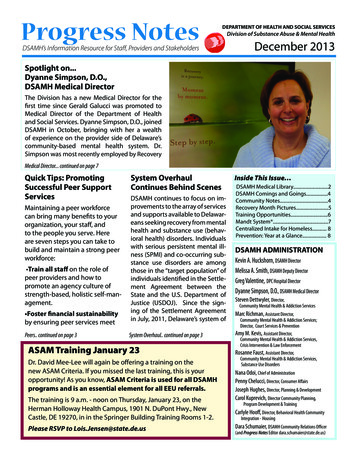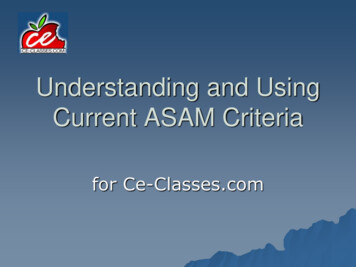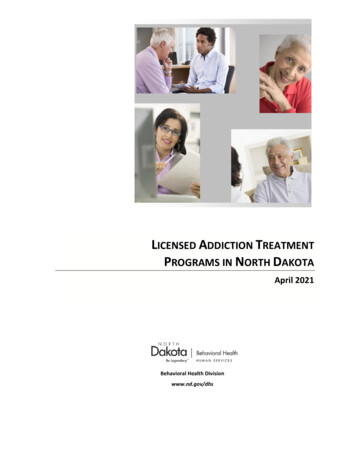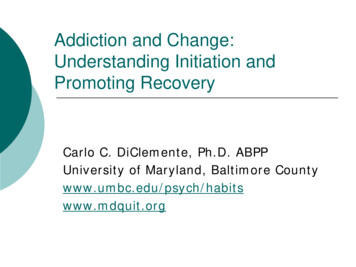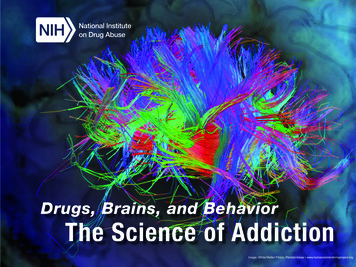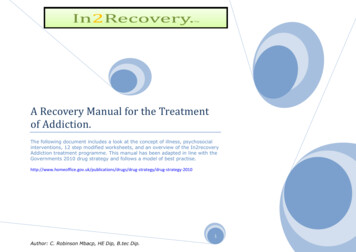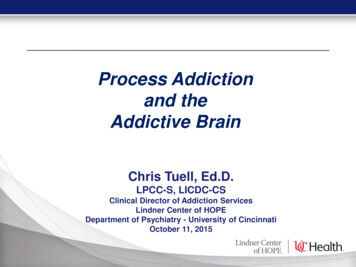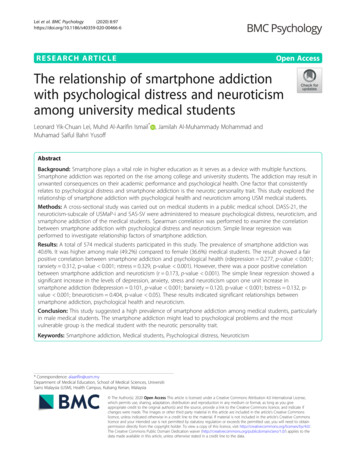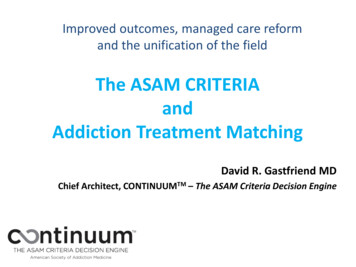
Transcription
Improved outcomes, managed care reformand the unification of the fieldThe ASAM CRITERIAandAddiction Treatment MatchingDavid R. Gastfriend MDChief Architect, CONTINUUMTM – The ASAM Criteria Decision Engine
Disclosure of Relevant Financial RelationshipsNameDavid tionships:What WasReceivedRelevantFinancialRelationships:For What RoleRecoverySearch, IncRoyaltyPres. & CEOAlkermes, IncShareholder,ConsultantFormer VP, Sci.CommunicationsNo RelevantFinancialRelationshipswith AnyCommercialInterests
Addiction assessment:A sorry state of affairs Non-standard, “intuitive”, then “find out the rest later ” Managed Care wants more data: Telephone tag (90 min – 3 days) Most insurers’ medical necessity criteria are Proprietary Absent precision & validity, emphasis is on cost, not quality 1991: ASAM Patient Placement Criteria a teaching tool States create their own Criteria (CASAM, MASAM, NYSAM, ) “ASAM” in Major US MCO: 50% of cases were denials on appeal: 50% reversed; on review 50% reversed again! By 2000s, SAMHSA & CSAT called on ASAM for a standard
Advances in Treatment MatchingModality Matching: many studies, e.g., Project MATCH – but few findings(Gastfriend & McLellan, Med Clin NA, 1997)Placement Matching: Multiple studies; ASAM model – consistent signals(Gastfriend, Addiction Treatment Matching, Haworth Press, 2004)Support: NIDA: Validation - R01-DA08781 & K24-DA00427 NIAAA: PPC-2R Assessment Software - SBIR grant R44-AA12004 CSAT: Access to Recovery Initiative - grant 270-02-7120 Belgian National Fund for Scientific Research Belgian American Educational Foundation Central Norway Health Trust /Rusbehandling Midt-Norge SAMHSA: Open Behavioral Health IT Architecture Program
ASAM text: hundreds of decision rulesTo place patients in the least intensive & restrictive carethat meets the patient’s multi-dimensional needsand affords optimal treatment outcomewww.haworthpress.comwww.ASAMcriteria.org
ASAM Patient Placement Acceptance/ResistanceDiagnosisSeverityPatient Placement iness &Relapse ecision RulesLEVEL OF CARE1. Outpatient2. IntensiveOutpatient3. MedicallyMonitoredIntensiveInpatient4. MedicallyManagedIntensiveInpatient
ASAM PLACEMENT CRITERIALEVELS OFOF CARECRITERIA1. OUTPT2. INTENSIVEOUTPT3. MEDMON INPT4. MEDMGD INPTno riskminimalMedicalComplicationsno riskmanageablesome onsno risksevere risk24-hr acutemed. carerequired24-hr psych.& addictionTx requiredIntoxication/WithdrawalReadinessFor cemild severitycooperativebut requiresstructuremore symptoms,needs closemonitoringsupportiveless support,w/ structurecan copeRecoveryEnvironmentmoderatehigh resist.,needs 24-hrmotivatingunable tocontrol use inoutpt caredanger torecovery,logisticalincapacityfor outpt
ASAM PPC Decision Rules – Mr. D. Mr. D. is a 41 y/o MWM unemployed carpenter,referred by his wife, a nurse,who, after a recent relapse, will soon throw him outif he continues his daily 6-pack habit and Percocet. His history includes no prior withdrawal symptoms,but major depression with suicidal ideation,intermittent prescribed opiates for low back injury,& alcoholism in his father. He would now accept treatment,including abstinence from any opiates,restarting his antidepressant,& attending some AA meetings.
ASAM PPC Decision Rules – Mr. D.LEVELOF CARED I M E N S I O N123456WD Bio Psy Mot Rel Env4 - Med Mgd---3 - Med Mon-- ---2 - Day Tx ---Level21 - Outpatient -
ASAM PLACEMENT TreatmentPartial Hosp.1OTP2.1, abilitationHospital(MedicallyManaged)3.1, 3.3, 3.5, 3.74Withdrawal Management (L-1, 2.5, 3.2, 3.7, 4)Biomedical Enhanced (L-3.7)2.BiomedicalCo-Occurring Disorders Capable (L-2, 3)Co-Occurring Disorders Enhanced (L-2, 3)3.Emot’l/Behav’l4.Readiness5. RelapsePotential6.Environment
MGH-Harvard ASAM Criteria Validity StudyGastfriend, et al. Supported by NIDA grants # R01-DA08781 & K24-DA00427 Randomized controlled trial (RCT) in 3 Cities in Eastern MA Tested matched v. mismatched assignments with PPC-1 Compared Levels II (IOP) & III (Residential) Outcomes: No-show to step-down care Balanced for gender, ethnicity (N 700) Used computerized algorithm with blinded raters, patients & treaters– Based on instruments with known reliability– B.A. level interviewers achieved inter-rater reliability of 0.77 (ICC)
Under-Matching Worsens No Show to TreatmentFrom Inpatient Detox to Either Residential Rehab or Day Treatment:All patients, High Frequency Cocaine Users and Heroin UsersPercent No-Shows to Next Treatment70%p .00160%p .01950%Under-matchedpatients’no-show rate: 25% worseUnder-matchedpatients’no-show rate: 100% worse40%p .00130%Under-matchedpatients’no-show rate: 300% worse20%10%0%All Patients (N 700)Cocaine (N 183)Mis-matchedMatchedHeroin (N 279)
ASAM in Patients with Comorbid Symptoms(Angarita et al., JAM 2007)Supported by NIDA grants # R01-DA08781 & K24-DA00427
ASAM in Patients with Comorbid Symptoms(Angarita et al., JAM 2007)No-show rates: Comorbids vs. Non-Comorbids, by Matching Status80ComorbidsNon-ComorbidsPercent No-shows706050 90%worse403020100Under-matched toIOP but needs Resid’lMatchedto IOPMatchedto ResidentialOver-matched toResid’l but needs IOP*P 0.01Matching Status
PPC-2R Validity at 1-Month in Belgium(Ansseau et al., unpublished) Programs in 4 LOCs, naturalistically rated 201 subjects Recruited in equal proportions from the 4 LOCs Assessed by trained psychologists Outcomes: 1 month, 5-point global rating scale Assessors, patients, programs, & raters – all blind Results: Adequate matches (n 140) weresignificantly better than mismatches (n 27) (p 0.05)
ASAM-PPC 1 Validity at 3 Months in NYC(Magura et al., Am J Add’n 2003)Supported by NIAAA grant R01-AA10863
Alcohol use by naturalistic Levels of Care & mismatching (N 219)10*Drinking Days in Past orithm-Rated
Bed-Day Utilization over 1-Yr in the VA(Sharon et al., JAD 2003)Supported by NIDA grants # R01-DA08781 & K24-DA00427
Annualized Bed-DaysBed-day Use Pre- vs. Post-Naturalistic L-III Placements 35 24-mos Before30* 13 mos After2520 151050Adequate (II)Matched (III)Lesser LOC (IV)
Predictive Validity: The Norwegian StudyStallvik M, Gastfriend DR, Nordahl HMFunded by the Central Norway Health Trust Prospective, double-blind, multi-site (n 10) naturalistic design N 261, naturalistically placed by counselors across 3 counties Baseline (BL) interview & 3 mo. follow-up (F/U) Independent raters used ASAM Criteria Software 2nd Ed.-Rev. Outcomes at 3 Month Follow-Up:1) Dropout2) Drug use frequency3) ASI Composite Score Changes4) Recommended level of care at F/U
3-mo Drop-Out, Improvement & Stepdown Need# ASI SubscalesImproved at F/U% Drop Out at 3-Mo F/U100%790%80%70%60%50%40%Matched patientshave 30% bettershow rates30%20%10%0%Under- Matched Over-% of Patients Ready forStepdown at F/U (vs. BL)70%660%550%43Matchyields3X betteroutcomesStepdownSame LOCHigher LOC40%30%220%110%00%Under- Matched Over-Under- MatchedNaturalistic Match Status – According to ASAM SoftwareOver-
Conclusions The ASAM Criteria Software decision rules show face validity Technology provides good reliability & feasibility Comparison to other instruments shows good concurrent validity Predictive validity overall & with heroin, cocaine & comorbidity Valid for undermatching, AND for overmatching Predictive validity:– in multiple cultures/systems: public/VA; MA/NYC; Belgium/Norway– at multiple time-frames: immediate, 30-d, 90-d & 1-year– with multiple outcomes:no-show, global improvement, substance use,step-down readiness, rehospitalization
Addiction assessment: A Sea ChangeThree laws end discriminatory, firewalled, fee-for-service models The Affordable Care Act The Parity Act The Health Information Technology ActChange is HERE for payers, programs and clinicians: Parity REQUIRES published medical necessity criteria SUD managed care UR will become equitable Clinicians will be able to use the ASAM Criteriato definitively describe patient needs – and reform UR
Stakeholders in the Health IT eCounselorSupervisorSocietySystemAccreditation Body,Government
ASAM Criteria – Health Services Research National Treatment Center Study - 450 programs (U. of GA) 70% of respondents using ASAM Criteria by 1996 Single-level programs: 34% - 42% less likely than multi-levels (p .01) Dual diagnosis capable programs:3.4 times more likely to adopt (p .01) Programs closing within 24 mos.were less likely to be ASAM adopters in 1996 (p .05) Programs closing within 6 mos. – even lower baseline adoption
Predictors of ASAM Criteria Adoption(Chuang et al., JAM 2009)
Predictors of ASAM Criteria Adoption(Chuang et al., JAM 2009) More than half (57%) of programs routinely use ASAM Public managed care –significantly associated with use of PPC (OR 1.010, p .05) Private managed care –significantly associated with use of PPC (OR 1.024, p .05) CARF accreditation –significantly associated with use of PPC (OR 3.187, p .01)Note: CARF tends to focus on rehabilitation & behavioral healthstandards (vs. JCAHO, which is hospital-oriented)
Case Study: CRC Health Operates 145 sites treating 30,000 people Largest behavioral health provider in U.S. Devotes significant resources to payer approval Each center has 3-5 FTEs dedicated to UR 20% of cases are contested by payers 30% of MD time is lost interacting w/payers If this administrative time is reduced only slightly,the ASAM Software could yield substantial savings.HARVARD BUSINESS SCHOOL
Beta Testing: Milwaukee CountyN 7 counselors, daily use over 6 months in Central Intake Units “ overwhelmingly positive, very user friendly” “already use ASAM & ASI, but not as consolidated or organizedas the software – a big plus from the Central Intake Staff” “no challenges in the learning curve – very easy to use” “very comparable duration ( 2 hrs) vs. the prior approach;the Software does not add to the time” “a deeper look into the patient & what’s going on” County would like to expand County-wide ( 30 Intake Counselors) Would like Recovery Support Services & Mental Health modules
Dynamically driven reportwith variable content regions.
Clinical Decision Support: Output DSM-IV and DSM-5 Substance Use Disorders: Diagnoses & Criteria CIWA-Ar & CINA withdrawal scores (alcohol/BZs, opioids) Addiction Severity Index (ASI) Composite Scores Imminent Risk Considerations Access & Support Needs/Capabilities ASAM Level of Care recommendations– Including Withdrawal Management– Including Biomedically Enhanced Sub-level– Including Co-occurring Disorder Sub-levels (Capable, Enhanced) Also: If actual placement disagrees with Software,the clinician gets to justify the discrepancy
25 Participating Health IT Vendors* BestNotesBrain Resource.comCaminarCernerCompulinkComputalogic's MethodOneDocuTrakeHanaEnsoftek/Dr CloudFoothold TechnologyLauris / Integrated ImagingManageAttendanceMeadows Edge MedivanceOrion SystemsProcompQualifactsRamsellSigmund SoftwareSmartStratus EMRThe ECHO GroupTenEleven GroupWelligentWITS*as of March 10, 2015; others in process
A National Addictions Patient RegistryTreatmentProgramEHRProtectedRaw Data(Identifiers Health Info)Copied Data(Stripped of Identifiersbut withUnique Case tation Body,Government
Implications & Opportunities– Patient trajectories – stepdown, step up, drop out & re-entry– Episode of Care – what is it? Analysis & characterization– Level of Care Need as a disease staging system?– Follow-up/reassessment & change over time analysis– High resolution data for treatment planning– Multi-factorial patterns of placement discrepancies (proximity, coveragerestriction, counselor bias, patient preference, algorithm error)– Needs assessment – for states, counties, insurers– Casemix analysis & trajectories For planning capitated contracts For controlled clinical trials – now can control for Level of Care need– MediCal & Other Waivers: precise, real-time UR w/detailed data
DEPARTMENT OF HEALTH & HUMANSERVICES Centers for Medicare & MedicaidServices 7500 Security Boulevard, Mail Stop S226-12 Baltimore, Maryland 21244-1850July 27, 2015SMD # 15-003Re: New Service Delivery Opportunitiesfor Individuals with a Substance Use DisorderDear State Medicaid Director: States should use the ASAM Criteria as they develop a residential or inpatient SUDservice continuum In order to receive approval the assessment for all SUD services, level of careand length of stay recommendations must be performed by an independent third partythat has the necessary competencies to use ASAM Patient Placement Criteria.Specifically, an entity other than the rendering provider will use the ASAM Criteria.OPTIONS for States/Counties to propose the 1115 Waiver:1. Managed care organization vendor contract2. ASAM’s CONTINUUM
Addiction assessment:A new, state-of-the-art standardTHE PAST NOW Non-standard, intuitive Standardized, quantitative Telephone tag Rapid Prior Authorization Proprietary criteria Public domain criteria Emphasis on cost, not quality Emphasis on cost AND quality 1991: ASAM a teaching tool 2015: ASAM a decision tool Each statecreates its own Criteria A single national standardfor Criteria Managed Care Study: 50% of cases reversed Managed care: Willing to pilotAUTOMATIC prior authorization By 2000s, SAMHSA wantsa standard 2015, SAMHSAhas a standard
Making Budgets Go Further & Outcomes BetterASAM’s CONTINUUM :(compared to usual assessment/placement) 25% - 300% reductions in no shows to next stage of treatment 30% reduction in dropout from treatment 3X improvement in addiction severity outcomes at 3 months 25% increase in numbers of patients ready for stepdownLeading to Increased patient flow & revenues Decreased staffing demands for incomplete intakes & UR delays
Making Budgets Go Further & Outcomes BetterASAM’s CONTINUUM :Moves intake effort up front, reducing intake & dropout “churn” More admissions/less staff time/lower costs AND better morale Better performance on the HEDIS Engagement indicator Consistently greater improvements in substance use & severity Decreases in overall hospital bed-daysPayer/MCO gets: faster, better telephone prior auth & UR data; Potentially eliminating phone prior auth AND most UR With precise, quantitative, real-time data Opportunity for: Determination of Need analyses Opportunity for: QI “hotspots” alerts & targeting
For more information: gastfriend@gmail.com www.ASAMcontinuum.org
significantly associated with use of PPC (OR 1.010, p .05) Private managed care – significantly associated with use of PPC (OR 1.024, p .05) CARF accreditation – significantly associated with use of PPC (OR 3.187, p .01) Note: CARF
